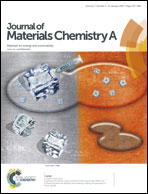A bipolar small molecule based on indacenodithiophene and diketopyrrolopyrrole for solution processed organic solar cells†
Abstract
A new linear A–D–A type low band gap small molecule (IDT-2DPP) based on 4,4,9,9-tetrakis(4-hexylphenyl)-4,9-dihydro-s-indaceno[1,2-b:5,6-b′]dithiophene (IDT) and 2,5-bis(2-ethylhexyl)-3,6-di(thiophen-2-yl)pyrrolo[3,4-c]pyrrole-1,4(2H,5H)-dione (DPP) was designed and synthesized by Pd-catalyzed Stille coupling reaction. IDT-2DPP exhibits good solubility and good thermal stability with a decomposition temperature of 395 °C. IDT-2DPP shows strong absorption from 500 to 700 nm with a high molar extinction coefficient of 1.3 × 105 M−1 cm−1 at the absorption peak (640 nm) in chloroform solution. The HOMO and LUMO levels of IDT-2DPP were estimated to be −5.11 and −3.32 eV, respectively. Solution processed bulk-heterojunction solar cells using IDT-2DPP as a donor material blending with PC71BM as an acceptor yielded a power conversion efficiency of 2.82%, and solar cells using IDT-2DPP as an acceptor material blending with P3HT as a donor yielded a power conversion efficiency of 0.83% with a high Voc of 1.17 V.


 Please wait while we load your content...
Please wait while we load your content...